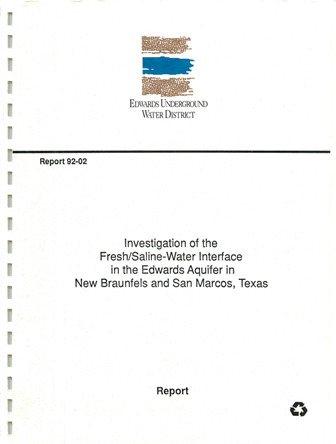Investigation of the Fresh/Saline Water Interface in the Edwards Aquifer in New Braunfels and San Marcos, Texas – Report

| Author | Poteet D, Collier H and Maclay R |
| Year | 1992 |
| Description | Attempts to define the freshwater/saline water boundary and its movement in the New Braunfels/San Marcos area from monitoring well data - Report |
| Report Number | 92-02 |
| Publisher | Edwards Underground Water District |
| Location | Edwards Aquifer, Balcones Fault Zone, San Antonio Segment, New Braunfels, San Marcos |
| Cover | View Download |
| File | View Download |
| Summary |
|
Two well transects, one In New Braunfels and one In San Marcos, were drilled for the purpose of: 1) collecting hydrogeologic data regarding the Interface between the fresh and saline zones of the Edwards Aquifer; and 2) monitoring the movement of the interface over a long period of time. Water samples, drill cuttings, and conductivity measurements were collected at various Intervals during the drilling of each well. Thin sections were made from the drill cuttings and then analyzed. Pump tests and geophysical logging were also performed at each well at various depths within the Edwards Aquifer. The data and resulting analyses presented in this report, therefore, details the hydrogeologic setting at each transect slte, and lays a technical foundation for the long-term monitoring of the fresh/saline Interface, as well as for other hydrogeologic studies regarding the Edwards Aquifer. For both sites, the transmissivity values were lower in the saline-water zone than in the fresh-water zone which corresponded with the lithology and porosity conditions observed in the geophysical logs, thin sections, and rock cutting descriptions. The water quality evidence also correlated with the trends related to the rock properties. In addition, the petrographic evidence revealed that at both San Marcos and New Braunfels, the rock where the wells were drilled was once exposed to fresh water. The drilling of both transects proved that the fresh/saline boundary was much closer to the major springs than previously believed. The most significant Information regarding the New Braunfels transect is that the interface between the fresh/saline zones was well defined and that a bottom saline layer persisted underneath the fresh-water zone where the wells were drilled. Thus, during some of the pump tests, the conductivity values in the wells increased. This change in water quality lead to a conservative conclusion that public supply wells in the same fault block should be monitored. The San Marcos transect did not cross an interface between the fresh/saline zone, rather only saline water was found. The transect however, did reveal a trend of Increased transmissivity toward the San Marcos Springs Fault. Moreover, though the quality of water was saline in the well closest to this fault, the water quality did improve over time during some of the pump tests. This Is believed to be caused by the Increase of transmissivity near such a major fault. However, communication from the lower block, where the wells were drilled, up the San Marcos Springs Fault to the spring orifices have yet to be established. |
Search for Documents
Advance Search
Explore EAA's Scientific Reports
- All Reports
- Hydrology and Hydrogeology
- History
- Groundwater Recharge, Recharge Zone
- Groundwater Movement
- Geomorphology and Caves
- Weather Modification
- Geology
- Water Use and Conservation
- Geochemistry
- Water Resources Planning and Management
- Floods and Drought
- Water Quality
- Climatology
- Surface Water / Groundwater Relationship
- Biology
- Springs, Groundwater Discharge
- Archaeology
- RZ Protection
- Aquifer Levels
- Remote Sensing
- Precipitation
- Overview Studies
- Modeling
